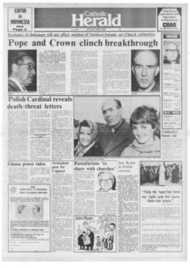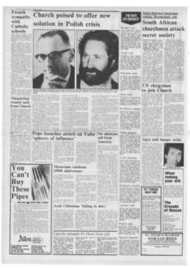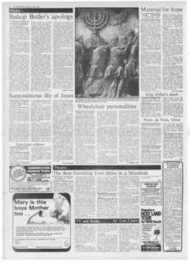Page 5, 22nd January 1982
Page 5

Report an error
Noticed an error on this page?If you've noticed an error in this article please click here to report it.
Tags
Share
Related articles
Parish In Focus: Our Lady Queen Of Heaven, Queensway
Pope Keeps A Date And Appeals For Unity
A Touch Of
Cathedral Turns Down Plastic Altar
Sculptor Of Devotion And Dignity
SPIRIT IN THE CLAY
ARTHUR Fleischmann has sculpted busts of four Popes. He must be a very serious man, I thought as I rang the bell to his house. My first mistake.
Standing on an orange box on the hall table was a bronze and enamel bust of Dame Edna Everage, alias Barry Humphries, the Australian entertainer. Butterfly-spectacles, bouffant dyed hair permanently recorded.
Dr Fleischmann's home is a small museum to his versatility. Near the front door is an alcove crammed with the exotic figures he produced during his period in the island of Bali. Next to them, the visitors' book is supported by an electrically lighted lectern in stratified perspex sheets.
Beside Dame Edna is a large screen in side-lighted carved perspex of the mysteries of the Rosary.
Arthur Fleischmann's life has been as varied as his art. He was born 85 years ago in Bratislava, then in the Austro-Hungarian Empire, now in Czechoslovakia. Between there and St John's Wood there have been new homes, new media, new styles. The art changes; the artist remains.
For the anniversary of St Anthony of Padua in 1932 he was sent by the Austrian Society for Religious Art to do the Austrian pavilion in Padua. It was then that he learnt Italian. The Italians wanted to make him a Commendatore, but he declined because he was not too keen on Mussolini. Now he is a Commendatore with honour as a Knight Commander of the Order of St Gregory.
In the ninth decade of his life, Fleischmann met Pope John Paul II. He hardly knew what language to speak to him. AS a youth, some of his schoolmates spoke Slovak, all spoke German. In the army in World War I, he served beside Poles and learnt their language.
He had trained as a doctor and specialised in dermatology. At the same time he studied sculpture. Bali held out a prospect of new subjects — but the dream came to an end when the island was threatened by the Japanese.
So Fleischmann moved to Australia and even became an Australian citizen. Again he pioneered new techniques — the bronze of Sydney public library were mad.e by electrolytic coating instead of hot casting. A temporary visit to England was prolonged again and again. Commissions multiplied.
He is still here and is settled with his lively and artistic wife, Joy and son, Dominic, now studying to be a marine engineer.
Over tea (with genuine muffins and honey) another example of Fleischmann's mastery of technique and medium was revealed. The table was a carved and pierced sheet of perspex under a glass cover, side-lighted. The cut edges have a, strange brilliance, more like ice than glass. The design was the northern sky, with the zodiacal signs carved around their constellations. My place had been set at my sign — Leo.
Half a century ago, Fleischmann made a tall reredos for a Westphalian church, with glazed terracotta figures of the 12 Apostles (to be exact, I I, leaving out Matthias, but adding St Paul). Each figure is more than life size in a simplified, stylised form, each with its proper attribute of keys or sword. The church was bombed in the war, but the figures survived to become the centre around which the new church was built. Last year, Dr Fleischmann rediscovered his altarpiece, unchanged but for the order of the figures.
Dr Fleischmann is careful to make his attitude to art and religion clear. "Christian art and religious art are not quite the same thing. Thirty years ago I was the president of a society of religious art and made it definite matter of principle in the society to include Mohammedans or Jewish people as members.
"There were three priests as 'founder members and they told us that the society could only work as an inter-denominational one — otherwise there was always a Catholic Art Guild. But it was too early and the society fell to pieces. If it had been after the Council. everything would have been all right Dr Fleischmann is clearly a man of deep religious committment, and the whole man is an artist. His work, serious or humorous, secular or religious, follows from his feelings. But much of his sculpture in Britain may be found in Catholic churches. In St Aidan's church, Acton. For example, on each side of Sir Graham Sutherland's altarpiece, Dr Fleischmann has made the Stations of the Cross in cement, with the backgrounds in mosaics, each connecting with the next. He has made Stations for half a dozen London churches and perhaps ten others, and never repeated himself.
As for the developments in his art, he says: "Of course f am more pleased with the newer art, or I'd still do the old. I don't like to part with my work and often keep duplicates. So I'm surrounded by works from half a century." In his shadowy studio, where he often works late into the night, a head of President Kennedy looks on at the work in progress, the bust of a princess, under wraps by day in black plastic to keep the clay damp. Out in the garden, a forest of sculpture takes on the appearance of a moon landscape under a cover of snow.
Differences in medium, Dr Fleischmann likens to writing in poetry or prose. "For me, medium is most important. Each material wishes to be treated in a different way. I can't do a piece of work and ask if I shall do it in bronze or marble."
Sculpture can be a connection between religion and the material world. Religious art shares both human and spiritual elements. "To represent angels, we are limited and try to represent religious ideas by things. Writers are freer because they can use abstractions. There may be a lot of abstract religious art, but generally speaking it is figurative and human. The idea is there in the sculpture."
To see one of Fleischmann's sculptures is to understand what tic
blog comments powered by Disqus











